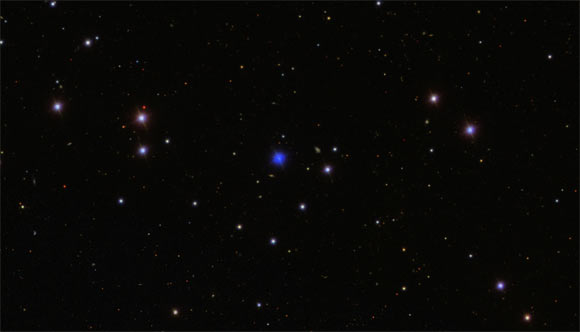New Class of Pulsating Stars Discovered | Astronomy – Sci-News.com
An international team of astronomers from the United States, Germany and Israel has discovered a new class of pulsators that vary in brightness every 5 minutes.

This image shows HIP 52181 (blue star in the center), a pulsating subdwarf O-star. Image credit: Centre de Données astronomiques de Strasbourg / SIMBAD / SDSS.
“Many stars pulsate, even our Sun does on a very small scale,” said Dr. Thomas Kupfer, a postdoctoral researcher in the Kavli Institute for Theoretical Physics at the University of California, Santa Barbara.
“A true pulsator can vary in brightness by some 10% due to a periodic change in its temperature, radius or both. Those with the largest brightness changes are usually radial pulsators, ‘breathing’ in and out as the entire star changes size.”
Initially, Dr. Kupfer and colleagues were searching for binary stars with periods less than an hour in observations from the Zwicky Transient Facility, a sky survey at the Palomar Observatory.
Four stars — ZTF J071329.02-152125.2, ZTF J184521.40-254437.5, ZTF J191306.79-120544.6, and ZTF J182815.88+122530.5 — stood out due to large changes in their brightness over just a few minutes.
Follow-up data quickly confirmed that they were indeed pulsators, not binary pairs.
According to the team, these stars are hot subdwarf pulsators (hot subdwarfs are stars about one-tenth the diameter of our Sun with masses between 20 and 50% that of the Sun; they’re incredibly hot — up to 90,000 degrees Fahrenheit (50,000 degrees Celsius).
“These stars have certainly completed fusing all of the hydrogen in their core into helium, explaining why they are so small and can oscillate so rapidly,” said Dr. Lars Bildsten, also from the Kavli Institute for Theoretical Physics.
“Scientists hadn’t previously predicted the existence of these stars, but in retrospect they fit well into the leading models of stellar evolution.”
Because of the stars’ low masses, they started life as typical Sun-like stars fusing hydrogen to helium in their cores. After exhausting the hydrogen in their cores, the stars expanded into the red giant stage.
Usually, a star will reach its largest radius and begin fusing helium deep in the core. However, the scientists think these newly-discovered pulsators had their outer material stolen by a companion before the helium became hot and dense enough to fuse.
In the past, hot subdwarfs were almost always related to stars which became red giants, started fusing helium in their cores, and then got stripped by a companion.
The new findings indicate that this group includes different types of stars.
“Some do helium fusion and some don’t,” Dr. Kupfer noted.
The stars’ pulsations allow researchers to probe their masses and radii and compare these measurements to stellar models, something that was not otherwise possible previously.
“We were able to understand the rapid pulsations by matching them to theoretical models with low mass cores made of relatively cold helium,” said Evan Bauer, a doctoral student at the University of California, Santa Barbara.
The results were published in the June 20, 2019 issue of the Astrophysical Journal Letters (arXiv.org preprint).
_____
Thomas Kupfer et al. 2019. A New Class of Large-amplitude Radial-mode Hot Subdwarf Pulsators. ApJL 878, L35; doi: 10.3847/2041-8213/ab263c





